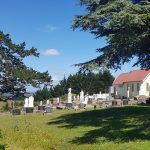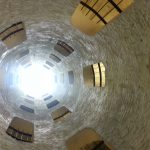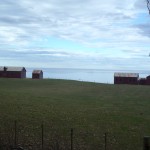After a pleasant night in Whanganui it was time to once more head south, this time along State Highway Three. But scarcely had I got on the road when a sign appeared advertising a “historic place” 400 metres ahead. There was no clue as to what this mystery place might be but in the dwindling moments before I passed by I made the snap decision to check it out. So I veered left off the highway and on to a dirt road which led directly into a field with only a small parking space to indicate that I was not trespassing on some unsuspecting farmer’s land.
I disembarked to see what happy little surprise lay in wait, and discovered a barn-like building perched atop a grassy outcrop commanding a decent view of the surrounding land. The red paint reminded me somewhat of the historic farm buildings at Matanaka, but in fact it turned out to be something quite different.
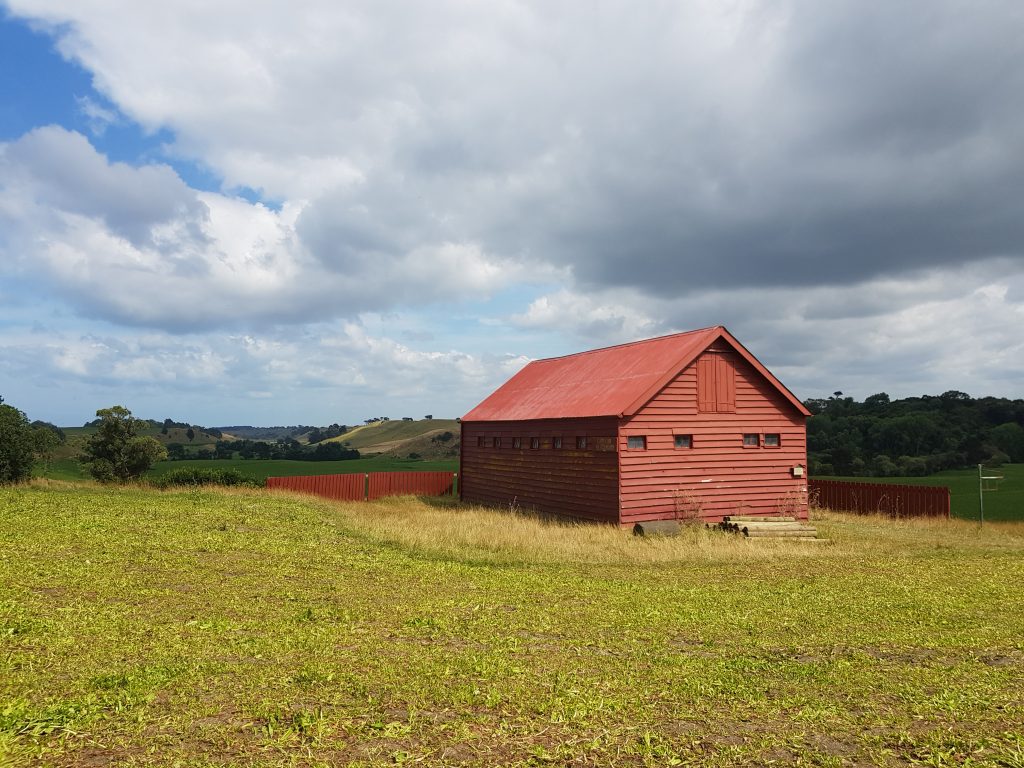
This building is one of the only remaining examples of an 1860s blockhouse, defensive buildings erected throughout the Taranaki, Wanganui and Auckland regions as tensions rose between European settlers who coveted land, and the local Māori who were becoming increasingly marginalised in the very lands over which they once held complete manawhenua. So unlike Matanaka this does not symbolise early New Zealand’s pioneering spirit, but rather (as Heritage New Zealand puts it) “personifies the level to which race relations had fallen in Victorian New Zealand”.
But how did it come to this?
James Cameron, the man who built the blockhouse, was born in Lochmaddy, Scotland, into the prestigious Cameron family of Callart. He was little more than twenty when he joined Moses Campbell and wife Jessie (also a Cameron, his first cousin once removed) along with their children on their voyage to New Zealand. The whole group travelled as cabin passengers on the New Zealand Company’s second ship to Wellington (and later the fifth ship to New Plymouth), so they would have had a far more comfortable voyage than my own ancestors two years later.
Both Moses and John had purchased land parcels from the New Zealand Company while still in Scotland, but like many others arrived to find that the Company’s promises failed to live up to the reality. The Company had theoretically purchased 40,000 acres (16,200 ha) on the banks of the lower Whanganui River for the new arrivals, but right from the beginning the validity and boundaries of this purchase were contested by various Māori groups.
That’s right, once again the New Zealand Company had sold more land than they actually had uncontested ownership of, so the settlers were forced to wait in limbo whilst their claims were sorted out. The group relocated to the town of Petre (now Whanganui) to bide their time until they could settle on the land that was owed them.

Jessie Campbell wrote of this time:
The Capt. often takes a stroll to see his country sections and each time seems more pleased with them. The chief to whom they belong made us a present lately of a dish of eels from our own lake, which had a superior relish coming from our own property. John Cameron shot a brace of wild duck the last time he was at the lakes, which we all thought superior to anything we had ever tasted.
Col. Wakefield has not returned from Auckland, he is daily expected accompanied by Shortland who is doing all he can to make himself popular during his short reign, he has done much good already and it is to be hoped will do still more by getting us settled on our land. The Chief, to whom our place belongs, says when he gets the price of the land he is quite willing to give it.
At this time John Cameron was sleeping on the couch in the Campbells’ residence, and Jessie had nothing but praise for him, calling him indispensable to the family. He had a large role in planning and building a house on their town section, in which he was finally able to claim a room of his own.
This was in 1842, but in 1843 an event occurred that shook the Europeans’ serene confidence that they would eventually receive what they were owed. Arthur Wakefield, brother of the above mentioned Colonel Wakefield and representative of the Nelson colony, was killed in the Wairau Affray, an unsettling sign of just how serious these conflicts could become.
To untangle the murky question the government brought in Land Commissioner William to review land purchases. In 1844 he ruled against the New Zealand Company, requiring them to compensate local Māori with claims on the land.
If you expected that would settle the matter once and for all, well…I appreciate your optimism.
Fighting broke out in the Hutt Valley in 1846, prompting the Whanganui settlers to build defensive works. Rising tensions culminated in the “Siege of Whanganui” in 1847. John Campbell and family wisely chose to relocate to Taranaki during this time.
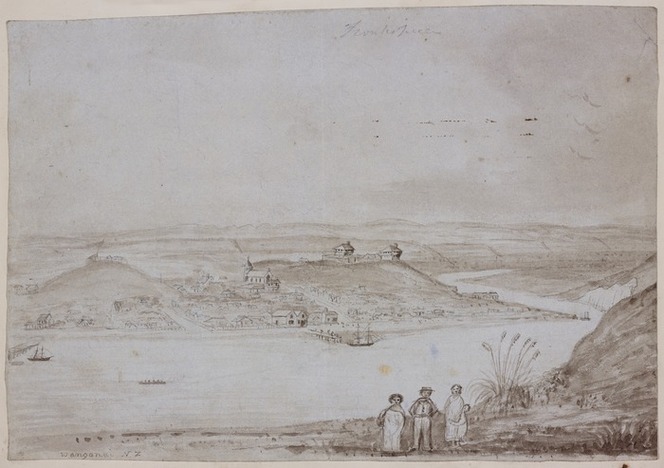
In 1848 peace was declared and the government negotiated a further purchase deal. Both John Campbell and John Cameron signed their names to an open letter thanking the New Zealand Company for their work to resolve the trouble. The settlers were finally free to take up their land, and John Cameron worked in partnership with the Campbells for some years before settling on his own property at nearby Marangai.
Do you think that settled the matter? No, I can see that you are beginning to understand the way this will go.
The outbreak of the First Taranaki War in 1861 brought the possibility of attack back into uncomfortable focus. This time John Cameron was prepared to take an active stand in defence of what had now been his home for the past 20 years, gathering together a force of like-minded volunteers to form a unit for the Wanganui Cavalry and taking the rank of Captain. They worked alongside Crown troops in 1865 against Pai Mārire converts, and in January were employed in reconnaissance to discover the location of the Waitotara Pa.
The mission was successful in that they located the pa (and were shot at for their trouble) however criticism was levelled at the volunteers when it emerged that they had gone out of their way to destroy a number of unoccupied Māori dwellings and killed farm animals belonging to them. Since many European settlers had also been forced to leave their homes and livestock unattended, this was considered a bad move that could only lead to retaliation in kind.
The Pai Mārire movement was considered fully defeated by February 1866, and by now if I told you that was the end of the matter you’d know I was pulling your leg.
Peace only lasted for two years this time before the outbreak of Titokowaru’s War in South Taranaki. Finally race relations in New Zealand had reached that famous nadir which the Cameron Blockhouse represents. This building was built on high ground as a place of refuge for settlers and their families should they come under attack. Its loopholed walls were packed with earth to help stop musket balls and it had line of sight with two neighbouring blockhouses located on the Campbell and Morgan farms, which could be signalled by way of flags or lanterns.
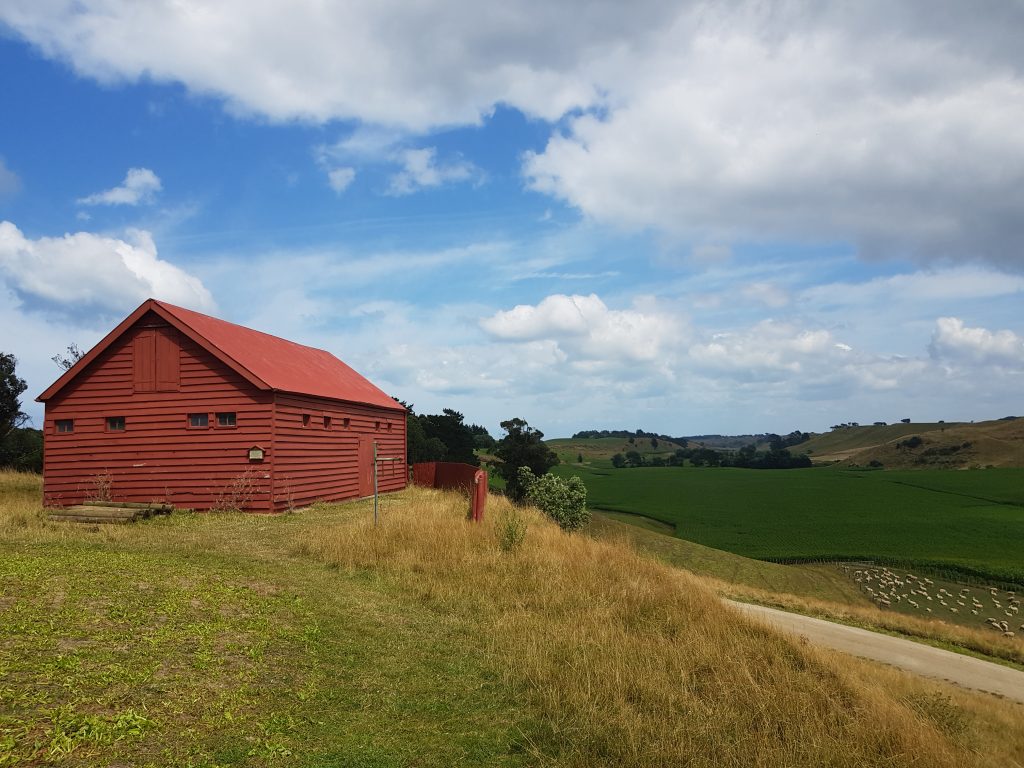
Inside, a ladder to the second story could be pulled up to protect the women and children who might shelter there.
The blockhouse never did come under attack, and by 1903 was being used as a stable. John Cameron passed in 1892, leaving four sons and one daughter. He was described as kind, unassuming, quiet, hospitable, and was remembered for his skill in horse breeding.
Between 1988 and 1990 the Cameron Blockhouse was restored by the Historic Places Trust, and now that the old stockades and fortifications are gone, it is all that remains to tell of a time when neither Māori nor pakeha could trust that their lives or their property would be safe. But a century and a half later we can surely say this has all been put behind us and the matter settled for good?
Well…almost. On 30 August 2019 Whanganui iwi signed an Agreement in Principle with the Crown, in order to settle their land claims under the Treaty of Waitangi, including $30 million in financial redress, the potential return of 22 sites, and – importantly – putting the H back in Whanganui.
Soon, very soon I am sure, a deed of settlement will be produced, and with that the Cameron Blockhouse will once and for all become a relic of a banished era.
You do believe me, don’t you?
References:
Captain Moses Campbell and Jessie Cameron
WELLINGTON. Press, Volume VII, Issue 691, 16 January 1865
THE FRONT. Taranaki Herald, Volume XIII, Issue 660, 25 March 1865
WANGANUI. New Zealand Herald, Volume II, Issue 380, 31 January 1865
WANGANUI.Taranaki Herald, Volume XIII, Issue 652, 28 January 1865
A TRAMP ABROAD. Wanganui Herald, Volume XXXVII, Issue 10894, 10 March 1903
Using Treaty settlement to put the H back in Whanganui by Leigh-Marama McLachlan,
Image Attributions:
Brees, Samuel Charles, 1810?-1865. Brees, Samuel Charles, 1810-1865 :[The town of] Petre Wanganui. [1844?].. Ref: A-179-014. Alexander Turnbull Library, Wellington, New Zealand. /records/23027347
[Taylor, Richard], 1805-1873 :Wanganui N. Z. [1848?]. Ref: E-296-q-159. Alexander Turnbull Library, Wellington, New Zealand. /records/22754338

